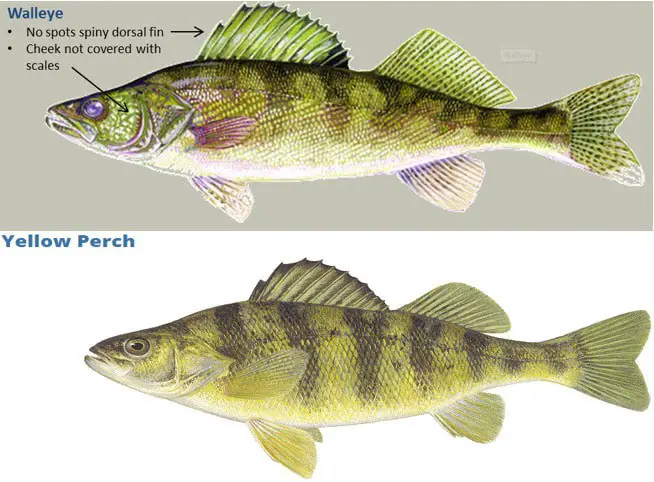
When I first heard this “rumor” about walleye actually being perch, I didn’t believe it, either. How could two fish that looked different and grew to such vastly different sizes be in the same family? However, far from being a rumor, that idea turned out to be fact.
The walleye does belong to the perch family and thus would be considered a perch. Walleye belong to the fish family “Percidae,” which means they belong to the same family as yellow perch, sauger, logperch, crystal darter, and fantail darter. This also makes walleye the largest fish in the perch family.
This was a bit of a surprise to me when I first learned about it, as I had just sort of assumed that walleye/sauger was sort of its own fish family.
However, a little bit of research has shown me that clearly isn’t the case, and so I guess technically from a family of fish stand point I’ve eaten way more perch than I previously thought!
Walleyes Are the Largest Perch
Considering that 2.5 lbs is a pretty sizable yellow perch, and the world record is under 6 lbs, it doesn’t come as a surprise that walleyes are the largest member of the family. To be honest, 2.5 lbs isn’t that much of a walleye at all and in fact during the 2018 Lake Erie fishing trip my brother caught a 27 incher that weighed over 8 lbs (not the one pictured in the walleye selfie).
In fact, the world-record walleye is 25 lbs which is almost 5 times the size of the world record yellow perch. That is definitely a noticeable size difference, even before comparing the lengths in which case the walleye was 41 inches long and the perch probably looked like a snack by comparison.
Each family of fish needs to have a king at the top of the scales, and in this case it’s definitely the mighty walleye.
 Why Is This Surprising?
Why Is This Surprising?
Most likely it’s because when someone mentions perch they are almost always referring to yellow perch. Bass could mean smallmouth or largemouth, trout could mean a half dozen species (same with salmon), but when someone is talking about perch it’s usually because they are thinking about the popular panfish.
They don’t think about a popular freshwater sports fish that can grow to really massive sizes that are well above and beyond what generally anyone thinks of the term “perch.” Also the fact that walleye and yellow perch are often found in the same water could lead to part of the confusion.
The walleye also just has some really distinctive features from the white tip of the tail (a great way to tell them apart from the very look-alike sauger) to the very pronounced sharp spines on the back fin. These just don’t make you think of a small perch, and it makes it easy to believe the walleye would be just its own family of fish.
Though the more you look at the two side by side, the more similarities actually become noticeable. This picture, a composite from a public domain pic from the Iowa DNR and one from the Oklahoma DNR, shows some clear differences between the two but also shows side by side there are definitely some common features. Just not as easy to see when one is 3 times the size of the other.
Whatever the reason, I’m not the only angler who has had this misconception in the past. This is a question plenty of people have had before, so don’t feel odd if you were among this group!
Looking at the Perch Family
There are just over 20 fish in the perch family, including all sub-species. Some are incredibly similar. Yellow perch and European perch, for example, are nearly identical though one is found in Europe (and has been introduced to Australia and New Zealand) while the other is native to Canada and the United States in North America.
The aforementioned walleye is by far and away the largest, but they are also really similar in appearance to saugers, as well. In fact, the two are incredibly hard to tell apart with only the smallest of differences giving one away from the other.
The vertical stripes are common among many of the different perch out there, as well as the fin patterns although not all perch have the spines that are so prevalent in some of the larger members of the family.
So there you go. While I don’t think my nearest fish association to walleye is ever not going to be sauger (also part of the same perch family) but walleye/sauger are not their own family. They are on the top of the perch hierarchy and now you know!

